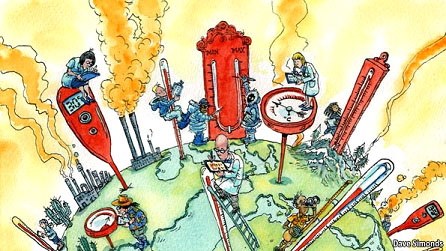A new analysis of the temperature record leaves little room for the doubters. The world is warming

FOR those who question whether global warming is really happening, it is necessary to believe that the instrumental temperature record is wrong. That is a bit easier than you might think.
There are three compilations of mean global temperatures, each one based on readings from thousands of thermometers, kept in weather stations and aboard ships, going back over 150 years. Two are American, provided by NASA and the National Oceanic and Atmospheric Administration (NOAA), one is a collaboration between Britain’s Met Office and the University of East Anglia’s Climate Research Unit (known as Hadley CRU). And all suggest a similar pattern of warming: amounting to about 0.9°C over land in the past half century.
To most scientists, that is consistent with the manifold other indicators of warming—rising sea-levels, melting glaciers, warmer ocean depths and so forth—and convincing. Yet the consistency among the three compilations masks large uncertainties in the raw data on which they are based. Hence the doubts, husbanded by many eager sceptics, about their accuracy. A new study, however, provides further evidence that the numbers are probably about right.
The uncertainty arises mainly because weather stations were never intended to provide a climatic record. The temperature series they give tend therefore to be patchy and even where the stations are relatively abundant, as in western Europe and America, they often contain inconsistencies. They may have gaps, or readings taken at different times of day, or with different kinds of thermometer. The local environment may have changed. Extrapolating a global average from such data involves an amount of tinkering—or homogenisation.
It might involve omitting especially awkward readings; or where, for example, a heat source like an airport has sprung up alongside a weather station, inputting a lower temperature than the data show. As such cases are mostly in the earlier portions of the records, this will exaggerate the long-term warming trend. That is at best imperfect. And for those—including Rick Perry, the Republican governor of Texas and would-be president —who claim to see global warming as a hoax by grant-hungry scientists, it may look like a smoking gun.
To build confidence in their methodologies, NASA and NOAA already publish their data and algorithms. Hadley CRU is now doing so. A grander solution, outlined in a forthcoming Bulletin of the American Meteorological Society, would be to provide a single online databank of all temperature data and analysis. Part of the point would be to encourage more scientists and statisticians to test the existing analyses—and a group backed by Novim, a research outfit in Santa Barbara, California, has recently done just that.
热门推荐:
考研网校哪个好
新东方考研培训班
考研培训班
考研培训机构哪个好
考研英语网络课程
文都考研网校
北京考研培训班

